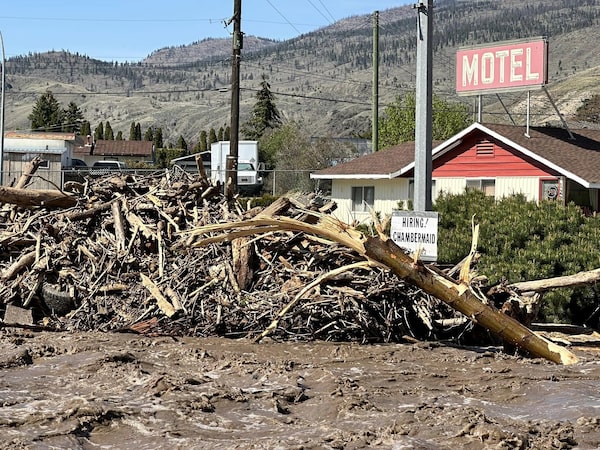
Floodwaters in the village of Cache Creek, B.C. The village was hit hard in recent flooding an the community's mayor said about six to eight businesses were severely affected.HO/The Canadian Press
Flood waters in the British Columbia Interior are receding and the rainfall that was expected to arrive over the weekend didn’t materialize, allowing residents in Cache Creek, Grand Forks and the Okanagan Indian Band to relax a little.
But for those hit hard by the past week’s flooding, recovery can be a long way off. About 50 people across the province remain under an evacuation order, and just over 2,000 remain under an evacuation alert, according to Bowinn Ma, Minister of Emergency Management and Climate Readiness.
At a briefing Monday afternoon, Ms. Ma said the Interior region can expect “a period of stabilization” for the rivers during the early part of the week, but warm weather expected later could increase flood risks.
David Campbell, head of the B.C. River Forecast Centre, said this year’s freshet is happening two or three times quicker than usual owing to the hot weather earlier in May.
“So this next period of warming, we’re anticipating additional round of accelerated snow melt. We can see again another period of elevated flood risk in the province and bringing on potentially new areas that have not experienced flooding,” he said at the briefing.
According to Ms. Ma’s office, there are about 149 properties on evacuation order due to freshet, and 164 properties remain under an order because of wildfires.
Businesses and residents in Cache Creek, a village about 350 kilometres northeast of Vancouver, were hit hard last week.
A video circulating online shows muddy water pouring out the ground floor of Cache Creek Motor Inn. The water once reached four, five-feet high, said Paramjit Parihar, the owner. He said he was notified by a customer around 3:30 a.m. that there was water coming into the room.
“It was scary, but nothing you can do,” he said.
Mr. Parihar’s hotel, which also has a Subway restaurant attached to it, was subsequently put under an evacuation order.
He said it may take a few months for the Subway to be restored, but the fate of the hotel is uncertain: “I’m not 100 per cent sure because they’re going to check the structure of that building if it’s still good or demolish the building.”
He said he isn’t sure whether he will receive any financial aid from the province.
Cache Creek’s mayor, John Ranta, said about six to eight businesses were severely affected.
“We were devastated for them. They are part of the economy of the community. When you lose businesses, you lose employees,” he said in an interview.
One resident, Angela Taylor, replaced some of her furniture in her basement after it was flooded in 2020. Last Tuesday, her property was again damaged by the water.
The water was “coming in faster than I can pump it out; my pump is running 24/7,” she said. “My place is nasty.”
She was not required to leave her home this time, but like many in her community, she is still on high alert.
Ms. Ma said the provincial government’s main focus right now is to support Cache Creek through the response of the flood.
“Understandably, there’s a lot of anxiety in the community,” she said, adding her team will have a conversation with the community about response and also about mitigating efforts that will prevent such an event from happening again.
Besides floods, the province is also contending with forest fires in the northeast. Two are burning on either side of Fort St. John. and combined with smoke from fires raging out of control in Alberta, the air is thick with smoke.
The Peace River Regional District downgraded some areas around the Boundary Lake wildfire from an evacuation order to an alert Sunday night, but an order for properties in the Red Creek and Lower Cache areas remains in place.
The regional district said 27 homes are still under an evacuation order for the Boundary Lake wildfire and 239 homes are under an alert.
Sixty-one properties remain under an evacuation order for the Red Creek wildfire, and 247 properties are under an alert.
With a file from The Canadian Press